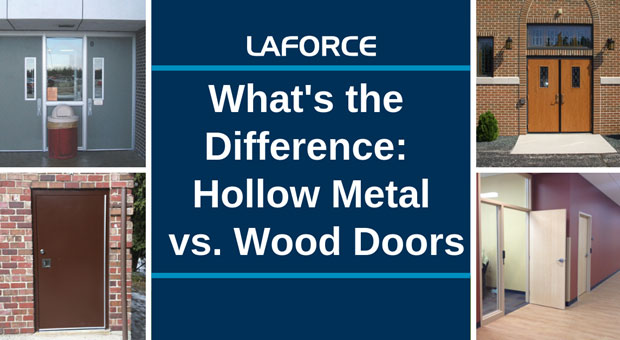When it comes to doors, LaForce offers a variety of materials and styles of doors for your facility. Two of the most common types of doors we supply are hollow metal and wood doors. What are the differences between these two popular doors? We have the answers for you!
Hollow Metal Doors
A hollow metal door is constructed by channel-reinforced sheet metal. Common hollow metal door cores include honeycomb, polystyrene, polyurethane, steel stiffened, and temperature rise. Hollow metal doors are typically used as exterior doors, or in an interior setting where a more durable door is needed such as a manufacturing facility. Hollow metal doors can have a fire-rating of up to three hours depending on the configuration.
A hollow metal door, if used in the interior of a facility, should have a lifespan the same as the building, unless it takes constant abuse without the correct protection. An exterior hollow metal door usually has a life span of 10 – 15 years depending on the climate it is located in. A hollow metal door can be protected by painting it a light color to help avoid thermal bowing and installing protection plates to avoid damage. Installing top caps, edge guards and seals are additional steps that can be taken to protect hollow metal doors.
Wood Doors
Wood doors are commonly used in the interior for both residential and commercial buildings. They can come in a variety of different veneers and style configurations. The four most common veneers are red oak, white maple, cherry, and white birch. Wood doors can have a fire-rating up to a maximum of 90 minutes. The veneer and the way the wood is cut for that particular veneer can greatly impact the appearance of the door
There are four different ways to cut wood door veneer to offer a varying appearance: plain sliced, rotary, rift and quarter cut. Check out the Masonite Architectural website to see detailed images of these four types of cutting styles.
Ideally, your wood door should have the same lifespan as the facility it is in, as long as it does not take excessive abuse. Most architectural wood door manufacturers offer a lifetime warranty for interior use. An alternate option, a Stile and Rail wood door can give the appearance of full glass, six panel, or 15 panel, along with many other configurations to give the opening a high-end feel. Painting/staining, as well as the application of protection plates, are steps to take to protect it from daily traffic as well as can give it a great aesthetic appeal. When caring for your wood door, be sure to use a light cleaning solvent and avoid installing the door in areas that lack temperature control.
LaForce is your door-opening experts for life safety. We can assist in finding the perfect door, style and more to match your facility and budget. Contact LaForce today to get started on your next project.



Follow Us